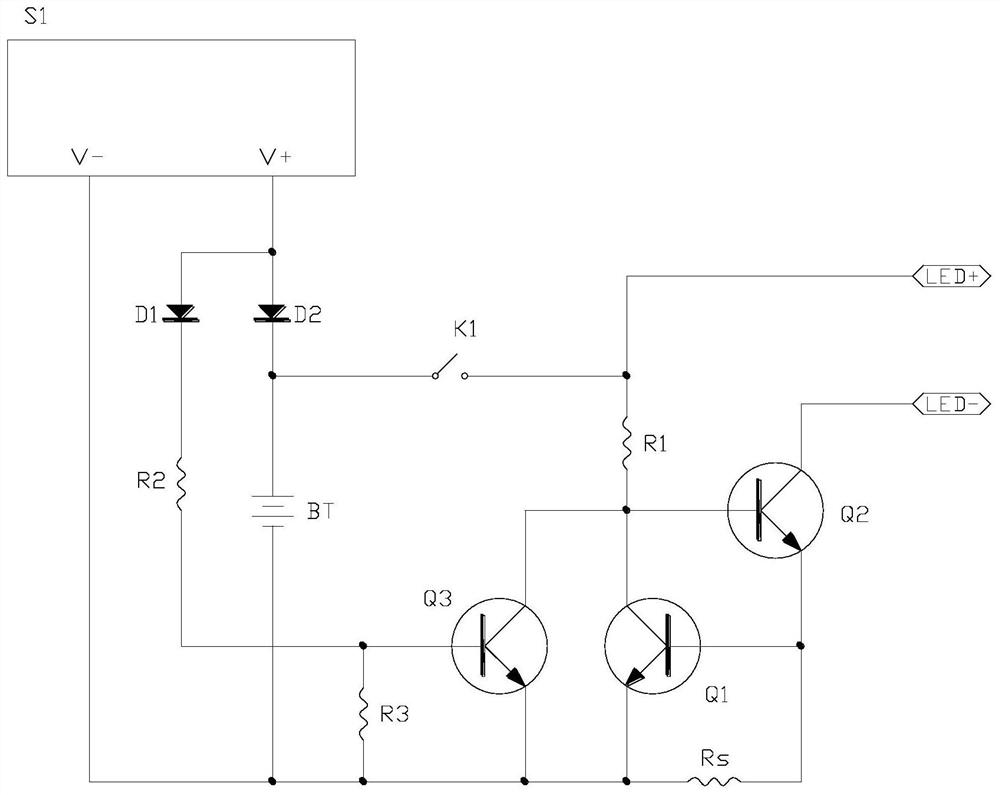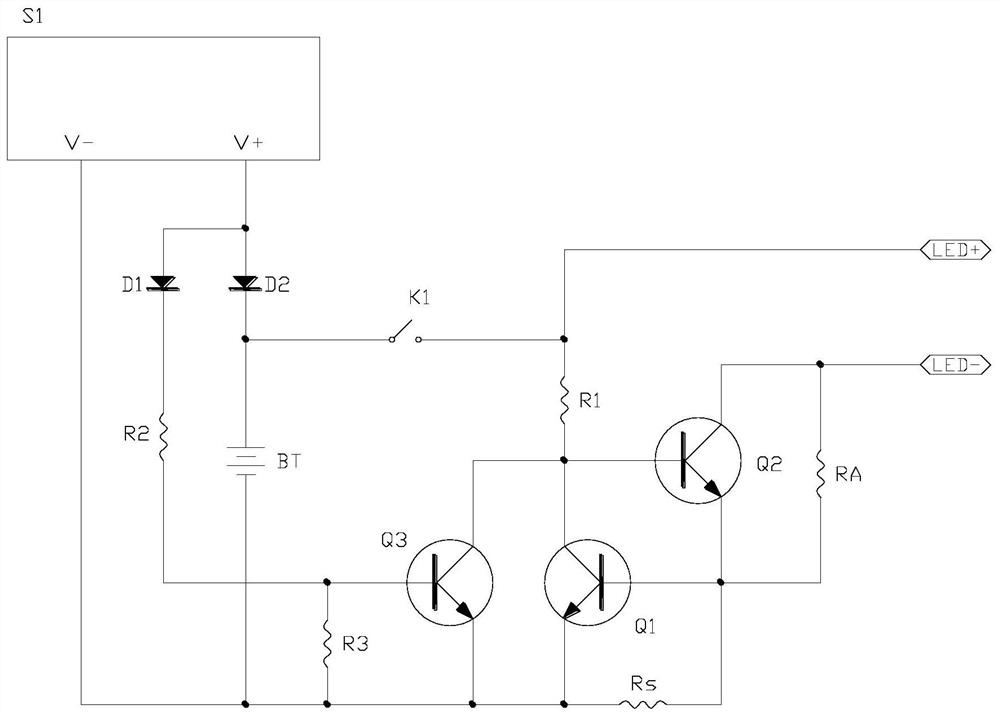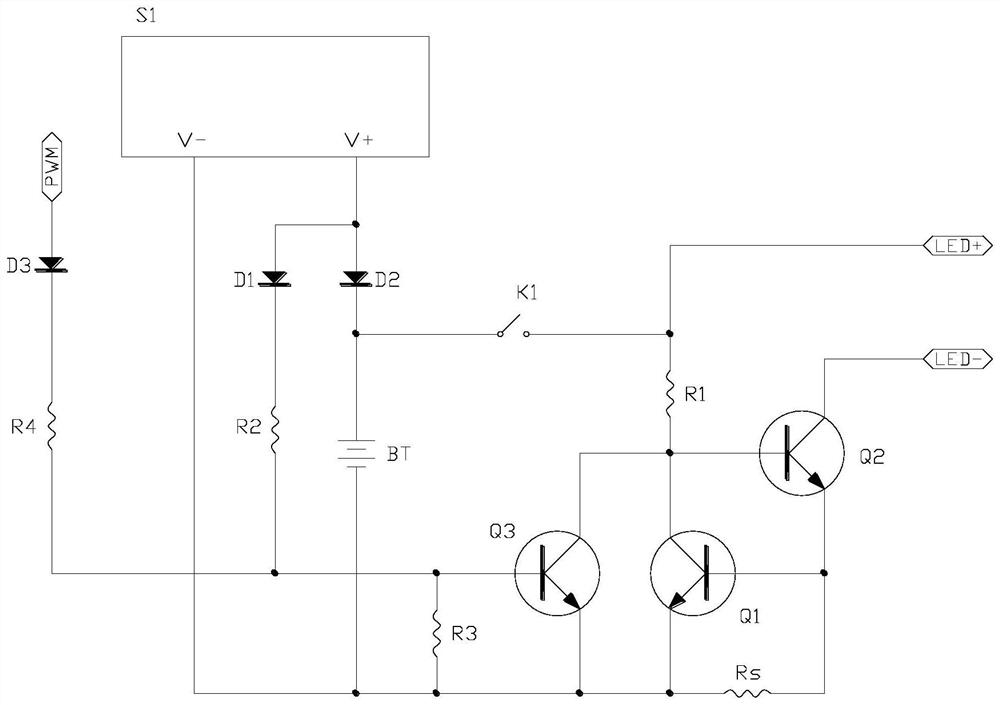Solar intelligent control type TLCC drive circuit
A technology of intelligent control and driving circuit, applied in energy-saving control technology, electrical components, etc., can solve problems such as power consumption and complex photosensitive process, achieve the effect of small price and supply impact, obvious circuit advantages, and alleviating the problem of lack of chips
- Summary
- Abstract
- Description
- Claims
- Application Information
AI Technical Summary
Problems solved by technology
Method used
Image
Examples
Embodiment 1
[0027] refer to figure 1 , a solar intelligent control type TLCC drive circuit of the present invention, including a photovoltaic module, an over-temperature protection module and an LED load, the photovoltaic module supplies power to the LED load through the over-temperature protection module, and the photovoltaic module includes a photovoltaic solar panel S1, Diode D1, diode D2, energy storage battery BT, voltage divider resistor R2, voltage divider resistor R3, switch K1 and transistor Q3, the base of the transistor Q3 is connected to the V-interface of the photovoltaic solar panel S1 through the voltage divider resistor R3 The connection is connected to the V+ interface of the photovoltaic solar panel S1 through the voltage dividing resistor R2 and the diode D1 at the same time, the emitter of the triode Q3 is connected to the V- interface of the photovoltaic solar panel S1, and the diode D2 and the energy storage battery BT Connected in series between the V+ interface and...
Embodiment 2
[0045] refer to figure 2 , a shunt resistor RA is connected between the collector of the triode Q2 and the emitter of the triode Q2.
[0046] Others are the same as embodiment one.
[0047] The shunt resistor RA added in parallel between the collector of the transistor Q2 and the emitter of the transistor Q2 in the TLCC drive circuit has a unique function of shunting and dividing power consumption, which can make the positive terminal of the LED load flow into the negative terminal of the LED load. The circuit is divided into two paths. One of the two currents directly flows through the collector of the transistor Q2 to the emitter of the transistor Q2 , while the other current flows through the shunt resistor RA and then flows to the emitter of the transistor Q2 . The two currents are finally brought together at the emitter of the transistor Q2, and then connected to the base of the transistor Q1 to form a loop to the ground through the constant current resistor Rs.
[00...
Embodiment 3
[0050] refer to image 3 , also includes a dimming module, the dimming module includes a diode D3, a current limiting resistor R4 and a pulse width modulator PWM, and the communication interface of the pulse width modulator PWM is connected with the voltage dividing resistor through the diode D3 and the current limiting resistor R4 One end of R2, one end of the voltage dividing resistor R3 are connected to the base of the triode Q3;
[0051] The pulse width modulator PWM switches the PWM signal to a floating or low level state, and uses the transistor Q3 to turn on the over-temperature protection module, so that the LED load and the photovoltaic module are conducted;
[0052] The pulse width modulator PWM switches the PWM signal to a high level state, and uses the transistor Q3 to close the over-temperature protection module, thereby disconnecting the phase between the LED load and the photovoltaic module.
[0053] Others are the same as embodiment one.
[0054] In the dimmi...
PUM
 Login to View More
Login to View More Abstract
Description
Claims
Application Information
 Login to View More
Login to View More - R&D
- Intellectual Property
- Life Sciences
- Materials
- Tech Scout
- Unparalleled Data Quality
- Higher Quality Content
- 60% Fewer Hallucinations
Browse by: Latest US Patents, China's latest patents, Technical Efficacy Thesaurus, Application Domain, Technology Topic, Popular Technical Reports.
© 2025 PatSnap. All rights reserved.Legal|Privacy policy|Modern Slavery Act Transparency Statement|Sitemap|About US| Contact US: help@patsnap.com



